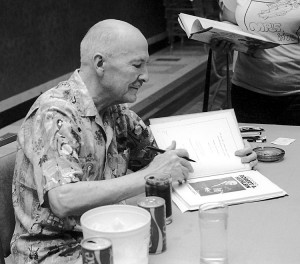This is the third in a series of Meaty Monday posts – longer posts where I ramble on about writing related topics. You can find the first Meaty Monday post here. This time I’m talking about Robert A. Heinlein’s five writing rules.
I first heard Robert A. Heinlein’s writing rules quoted by Neil Gaiman when he was in Vancouver promoting Anansi Boys and they’ve stuck with me ever since.
They were originally published in Heinlein’s 1947 essay On the Writing of Speculative Fiction (republished in Writing Science Fiction and Fantasy, among other places).
The bulk of the essay is about the types of science fiction stories (human interest or gadget-centric) and the three plots that human interest stories can have – “boy meets girl”, “the Little Tailor” (the little guy who becomes a big shot or vice versa) and “the man who learned better”. It’s Heinlein’s five rules or “business habits” as he calls them that have gained the most attention though.
1. You must write
This one is obvious really, let’s face it, but all around the world there are people that would like to be writers but aren’t actually doing any writing.
2. You must finish what you start
More good, solid advice. This is one I follow 80% of the time. I have my abandoned folder for stories I’ve given up on for the time being, and the first sixty-odd thousand words of a novel I began a very long time ago but generally I try to finish what I start. And by finish I mean write the story, then revise it until I’m as happy with it as I think I can be.
3. You must refrain from rewriting except to editorial order
This is the one that gets Heinlein into trouble – very few people think you should write a single draft of a story and then start sending it out. There’s several ways to interpret this particular rule.
a) Assume he actually meant something different – like don’t endlessly rewrite.
b) Assume that he did mean what he said but that it no longer applies because the market has changed. When Heinlein was writing it was entirely possible to earn a living by writing short stories, as long as you were prolific enough. That basically meant churning them out and hoping you got enough sales to cover the rent.
c) Assume that “finish what you start” includes revision and polish, making a rewrite in this context exactly that – a rewriting of your story.
Or you can do what I do which is not worry about it too much and move on.
4. You must put it on the market
You’ve found the time to write, you’ve finished your story – NOW SEND IT OUT!
No one every published a story of any kind by writing it and putting it in a drawer. No one.
Pick an appropriate market, read their guidelines, follow them to the letter and send them your story. In Heinlein’s day (and some of mine) that meant producing a hard copy of your story in the appropriate format, sticking it in an envelope and putting it in a postbox (with a stamped self-addressed envelope of course) and waiting.
Nowadays, it’s much easier; most publications accept electronic submissions of some sort and sites like Clarkesworld have fancy schmancy submission systems that do half the work for you. You still need to wait though. And follow their guidelines, don’t forget that. Forgetting that would be bad.
5. You must keep it on the market until sold
There’s a huge amount of luck involved in getting a story published. The world is full of stories and novels that were rejected hundreds of times before the right slush reader in the right mood passed it on to the right editor who was also in the right mood and had the right gap in their publishing schedule to publish it to great critical and commercial success. Don’t give up on your story after the first rejection – send it out again as soon as you can and keep sending it out until it finds a home.
I have a handful of my favourite sites and magazines that get any story I think is appropriate for them but once I’ve exhausted those, I prowl Duotrope’s weekly email updates, looking for suitable candidates for my homeless stories.
The key word there is suitable. Think about where you’re sending your stories – read a couple of issues if you can – and only submit if you think your story fits the market. That way you’re helping the editor by making sure they aren’t wasting their time on your story and you’re helping yourself by making sure you don’t sit at home waiting for an acceptance that’s never going to arrive. It can take a long time to get a reply – my first acceptance took 308 days and I’ve had numerous 100+ day rejections – so don’t waste your time by sending your splatterpunk story to Highlights.
Those are Heinlein’s rules and, as much as possible, that’s how I live my writing life. I’ll leave you with some closing comments on the rules from Heinlein’s essay…
“…if you follow them, it matters not how you write, you will find some editor somewhere, sometime, so unwary or so desperate for copy as to buy the worst old dog you, or I, or anybody else, can throw at him.”
Robert A. Heinlein – On the Writing of Speculative Fiction

Robert A. Heinlein at the 1976 World Science Fiction Convention
Heinlein’s Writing Rules
Philip Harris – 18th June 2012